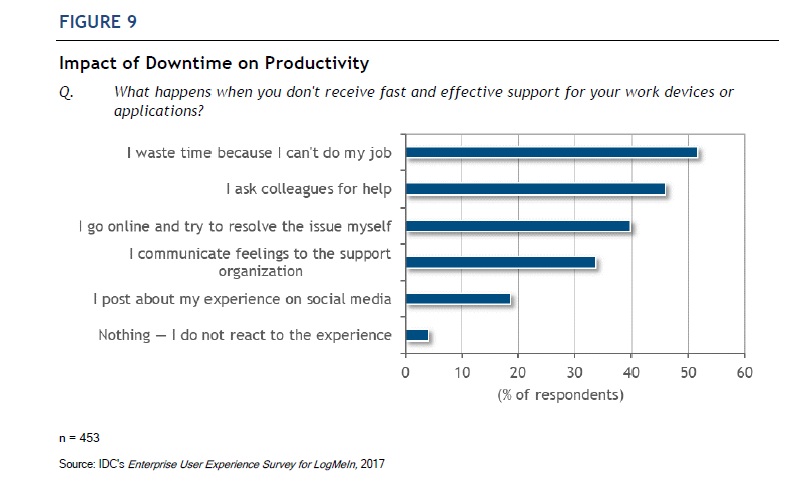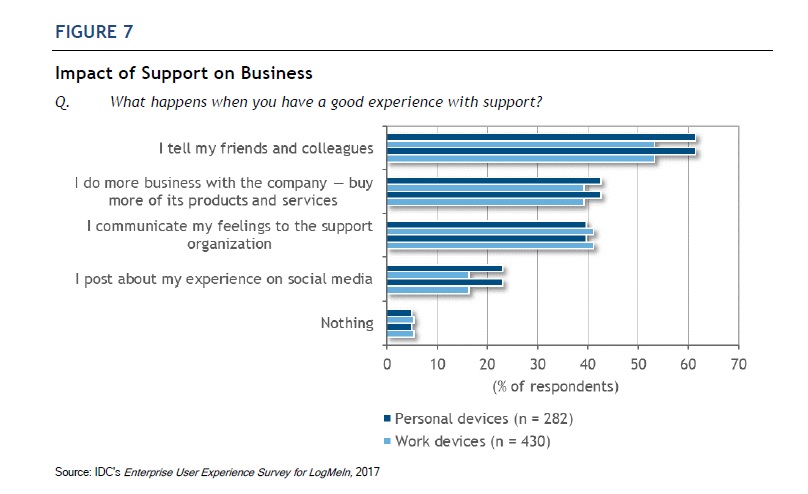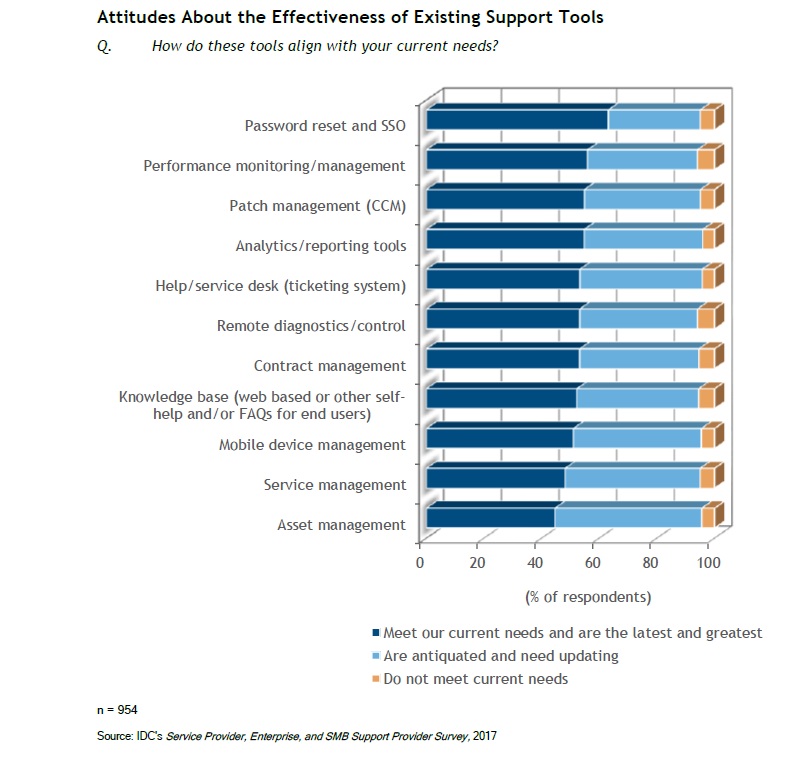Most Organizations Agree that Providing Good Support is a Top Priority, But IDC’s Survey Sponsored by LogMeIn Shows that Investing in Tools to Drive Improvement Remains a Challenge
 The newer generation of “millennial” and Gen X workers is much more vocal than baby boomers when something good happens. Take, for example, consumer support scenarios; when younger people have a positive experience with support, they share this experience on social media much more often than older people do. This data confirms that effective support can be used as a competitive differentiator and has the power to drive more business and therefore more revenue.
The newer generation of “millennial” and Gen X workers is much more vocal than baby boomers when something good happens. Take, for example, consumer support scenarios; when younger people have a positive experience with support, they share this experience on social media much more often than older people do. This data confirms that effective support can be used as a competitive differentiator and has the power to drive more business and therefore more revenue.
Ineffective support systems according to the study by LogMeIn and IDC entitled “Support Services as a Competitive Differentiator”, nearly 67% of consumers said that customer satisfaction was more important than price when doing business with a company.
Nearly 30% of companies still say that reducing the cost of support is more important than customer satisfaction.
With the rules of customer and employee engagement changing, this disconnect is setting companies up for a negative long-term impact.uses drop in productivity and damage to company reputation
The ability to provide fast and effective service is inextricably linked with customer satisfaction, worker productivity, and business success. Support providers should examine their maturity in their ability to deliver service and prioritize investment to move into more mature phases to not only meet the needs of a changing customer base but also use this service as a means to strengthening their partnerships with customers. A great need exists in the market for reaching customers in new ways and helping them, in turn, connect with their end customers.
While most organizations agree that providing good support is a top priority, IDC’s survey findings show that when it comes to investing in tools that will drive improvement, many organizations remained challenged to fund these investments.
Improving productivity
Knowing the coming demands on support organizations including more devices, more mobility, and an increasingly distributed and global end-user customer base, IDC believes that investment in advanced technologies, streamlined processes, and people skills is necessary. Organizations that do so will be able to differentiate their business and improve productivity by expanding their ability to communicate in a multitude of ways and being flexible to adapt to changing preferences.
 Support organizations are positioned well to shape customers’ perceptions and drive greater loyalty; this inextricable link provides an opportunity for support organizations to differentiate and drive more revenue for their company. When consumers have a good experience with support, they buy more products from the company and implore their friends and colleagues to do the same. Social media and propensity to share positive and negative experiences are important to factor into support strategies because they highlight and underscore the critical value of a support organization to the business.
Support organizations are positioned well to shape customers’ perceptions and drive greater loyalty; this inextricable link provides an opportunity for support organizations to differentiate and drive more revenue for their company. When consumers have a good experience with support, they buy more products from the company and implore their friends and colleagues to do the same. Social media and propensity to share positive and negative experiences are important to factor into support strategies because they highlight and underscore the critical value of a support organization to the business.
Enabling innovation
Support organizations’ strategies and measurements for success are often aligned with broader company goals of customer satisfaction and retention. Most organizations have a customer success organization that reports into top leadership, highlighting the recognized importance of the support organization. This structure is a critical first step in driving positive change for a support organization — having the attention of upper management. With this attention comes scrutiny as well, and support organizations that are proactive and prepared to meet the coming demands are more likely to be perceived as an enabler to innovation and transforming the customer experience. Those that are not prepared will be viewed as a barrier to success.
Read More: Swrve Introduces Intent Engine With Support for Real-Time Audience Profiling
Cost versus customer
Broadly categorizing support organizations, IDC believes that about 20–25% are stagnant and at risk of being recognized as a detriment to customer loyalty and satisfaction. About 50% have made some changes to their internal processes, or made an investment in technologies, but are considered less mature because they have not been able to adjust support needs for specific user types and have a limited ability to speed the time to resolution. Only about 25% are able to drive strong partnerships with customers based on the adaptability and intelligence of their support organization. These more mature support organizations have made more coordinated efforts for improvements including their internal processes and more advanced toolsets.
 What is concerning is the large number of organizations that are prioritizing cost over the customer experience. This may prove to be a short-term strategy for cost reduction that will have a long-term impact on the company overall. For organizations facing a challenge of justifying investment in improving the support experience, the ability to link customer loyalty and perception with company growth is vital.
What is concerning is the large number of organizations that are prioritizing cost over the customer experience. This may prove to be a short-term strategy for cost reduction that will have a long-term impact on the company overall. For organizations facing a challenge of justifying investment in improving the support experience, the ability to link customer loyalty and perception with company growth is vital.
Technology-led support

Chris Savio, Director, Remote Support Solutions, LogMeIn, said, “There are a lot of factors that go into a business’ ability to stay competitive in today’s digitally transformed world. What our study showed is that having fast, effective support is a critical component in how customers view a company and ultimately whether they will continue to do business with them. The ability for companies to provide the level of support today’s connected customer demands is often contingent on the tools and technologies the support teams are armed with.
 “Technologies like remote support, artificial intelligence and even augmented/virtual reality are helping support teams do their jobs quicker and delight customers than more traditional methods. For example, support solutions that include some level of self-help and automation lend themselves to faster support interactions with frequent and more repetitive tasks being handled with no or limited agent interaction. This opens agents up to handle more complex tasks, provides faster time to resolution for those simpler requests – all with low-end user effort. And this is important — with 67% of consumers closely relating their support experience with their feelings about the company, happy customers become brand evangelists that help bring in more revenue in the long-term,” said Savio.
“Technologies like remote support, artificial intelligence and even augmented/virtual reality are helping support teams do their jobs quicker and delight customers than more traditional methods. For example, support solutions that include some level of self-help and automation lend themselves to faster support interactions with frequent and more repetitive tasks being handled with no or limited agent interaction. This opens agents up to handle more complex tasks, provides faster time to resolution for those simpler requests – all with low-end user effort. And this is important — with 67% of consumers closely relating their support experience with their feelings about the company, happy customers become brand evangelists that help bring in more revenue in the long-term,” said Savio.
Enacting change requires a holistic approach that includes garnering widespread organizational support as well as investment in tools and processes to enable the shift to a more proactive and adjustable support program.
Recommended Read: Create Deeper Connections to Drive Conversion, Close Deals with End-to-End Personalization











